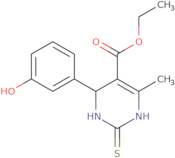Monastrol
CAS: 329689-23-8
Ref. 3D-ENA68923
| 5mg | Ausgelaufen | ||
| 10mg | Ausgelaufen | ||
| 25mg | Ausgelaufen | ||
| 50mg | Ausgelaufen | ||
| 100mg | Ausgelaufen |
Produktinformation
- 5-Pyrimidinecarboxylic acid, 1,2,3,4-tetrahydro-4-(3-hydroxyphenyl)-6-methyl-2-thioxo-, ethyl ester
- 5-Pyrimidinecarboxylicacid, 1,2,3,4-tetrahydro-4-(3-hydroxyphenyl)-6-methyl-2-thioxo-, ethyl ester
- 6-Methyl-4-(3-hydroxyphenyl)-2-thioxo-1,2,3,4-tetrahydropyrimidine-5-carboxylic acid ethyl ester
- 6-Methyl-4-(3-hydroxyphenyl)-2-thioxo-1,2,3,4-tetrahydropyrimidine-5-carboxylicacid ethyl ester
- Ethyl 1,2,3,4-tetrahydro-4-(3-hydroxyphenyl)-6-methyl-2-thioxo-5-pyrimidinecarboxylate
- Ethyl 4-(3-Hydroxyphenyl)-6-Methyl-2-Thioxo-1,2,3,4-Tetrahydropyrimidine-5-Carboxylate
- ethyl (4R)-4-(3-hydroxyphenyl)-6-methyl-2-thioxo-1,2,3,4-tetrahydropyrimidine-5-carboxylate
- ethyl (4S)-4-(3-hydroxyphenyl)-6-methyl-2-thioxo-1,2,3,4-tetrahydropyrimidine-5-carboxylate
Monastrol is a natural compound that has been shown to promote axonal growth in the central nervous system. It also induces pluripotent cells from mouse embryonic stem cells, which are capable of differentiating into all three germ layers. Monastrol has been found to be effective against leishmania and skin cancer in mice. Monastrol inhibits mitosis by binding to the ATP-binding site on tubulin and preventing the formation of microtubules, leading to cell death. Monastrol also binds to the mitochondrial membrane and causes depolarization, which leads to cell death by apoptosis.





